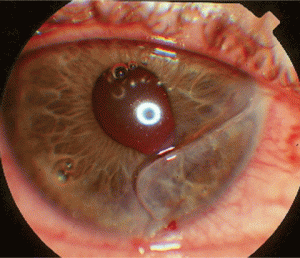
Optometric Education Consultants Clinical Case Challenge
A 21 year old male plumber called in requesting an urgent appointment. He was working on a job and trying to dislodge a drain coupling by hammering it with the blunt end of a screw driver. He missed, recoiled, and hit himself in the eye, presumably with the sharp end of the screw driver. He reported over the phone that he was tearing and that fluid was running down his cheek. He took some Tylenol and the pain was subsiding a bit. He noticed a “loose flap of skin” on his eye that he was trying to manually remove. Discussing his adventures over the phone led to a myriad of possible consequences and he was told to come in immediately.
Fortunately, he came in immediately as he had a full thickness corneal laceration with a flat chamber and bubbles in his anterior chamber (which is not a good sign of corneal patency). His adventures relayed over the phone were easily explained. The fluid running down his cheek was aqueous, the loose flap of tissue that he was trying to pull off was, in fact, his cornea, and Tylenol didn’t relieve the pain as much as severing his corneal nerves did.
Dealing with open globe injuries such as this can be challenging. Potential findings may include pain, lacrimation, decreased vision, and (+) Seidel’s sign; additionally you may also see hyphema, anterior chamber inflammation, a flattened anterior chamber, even air bubbles in the chamber as in this case. Iris prolapse possible and may actually plug the wound in some cases. Do not perform tonometry or otherwise manipulate the eye due to the possibility of extruding uveal tissue and worsening the situation. The least done the better. Shield the eye (but do not patch), instruct the patient not to eat or drink (in case surgery will be imminently performed), and refer immediately for surgical repair.
Some perforations can self-seal and may not manifest a positive Seidel test. Even if this happens, there still exists the possibility of an infective organism gaining access to the internal eye with subsequent endophthalmitis. Always consider any high speed injury to be a globe perforation until proven otherwise and perform a dilated exam and, if possible, B scan ultrasonography. Progressive vision loss, redness, sensitivity to light, pain, inappropriate inflammation, hypotony, and a shallow anterior chamber should alert to the possibility of an open globe injury and endophthalmitis, necessitating emergency referral to a retinal specialist.
In the case of this 21 year old plumber, surgical repair was delayed over half-a-day due to insurance reasons and an inability to locate a surgeon agreeable to taking on the case. Ultimately, he had a surgical repair done by a general ophthalmologist through a local emergency room at 11:30 pm that night. He did not develop endophthalmitis and ultimately had a final visual acuity of 20/30+ in that eye. He was reminded that there is a right tool to use for every job.

what kind of surgery would this be?
It was corneal suturing. Small defects can be glued.